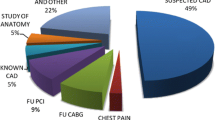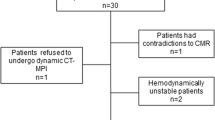Abstract
Cardiac computed tomography permits quantification of coronary calcification as well as detection of coronary artery stenoses after contrast enhancement. Moreover, cardiac CT offers high-resolution morphologic and functional imaging of cardiac structures which is valuable for various structural heart disease interventions and electrophysiology procedures. So far, only limited data exist regarding the spectrum of indications, image acquisition parameters as well as results and clinical consequences of cardiac CT examinations using state-of-the-art CT systems in experienced centers. Twelve cardiology centers with profound expertise in cardiovascular imaging participated in the German Cardiac CT Registry. Criteria for participation included adequate experience in cardiac CT as well of the availability of a 64-slice or newer CT system. Between 2009 and 2014, 7061 patients were prospectively enrolled. For all cardiac CT examinations, patient parameters, procedural data, indication and clinical consequences of the examination were documented. Mean patient age was 61 ± 12 years, 63% were males. The majority (63%) of all cardiac CT examinations were performed in an outpatient setting, 37% were performed during an inpatient stay. 91% were elective and 9% were scheduled in an acute setting. In most examinations (48%), reporting was performed by cardiologists, in 4% by radiologists and in 47% of the cases as a consensus reading. Cardiac CT was limited to native acquisitions for assessment of coronary artery calcification in 9% of patients, only contrast-enhanced coronary CT angiography was performed in 16.6% and combined native and contrast-enhanced coronary CT angiography was performed in 57.7% of patients. Non-coronary cardiac CT examinations constituted 16.6% of all cases. Coronary artery calcification assessment was performed using prospectively ECG-triggered acquisition in 76.9% of all cases. The median dose length product (DLP) was 42 mGy cm (estimated effective radiation dose of 0.6 mSv). Coronary CT angiography was performed using prospectively ECG-triggered acquisition in 77.3% of all cases. Tube voltage was 120 kV in 67.8% of patients and 100 kV in 30.7% of patients, with a resultant median DLP of 256 mGy cm (estimated effective dose of 3.6 mSv). Clinical consequences of cardiac CT were as follows: in 46.8% of the cases, invasive coronary angiography could be avoided; ischemia testing was recommended in 4.7% of the cases, invasive coronary angiography was recommended in 16.4% of the cases and change in medication in 21.6% of the examinations. Cardiac CT is performed in the majority of patients for non-invasive evaluation of the coronary arteries. CT frequently resulted in medication change, and otherwise planned downstream testing including invasive angiography could be avoided in a high percentage of patients. Radiation exposure in experienced centers is relatively low.
Similar content being viewed by others
References
Roffi M et al (2015) ESC Guidelines for the management of acute coronary syndromes in patients presenting without persistent ST-segment elevation: task force for the management of acute coronary syndromes in patients presenting without persistent ST-segment elevation of the European Society of Cardiology (ESC). Eur Heart J 37(3):267–315
Task Force Management et al (2013) ESC guidelines on the management of stable coronary artery disease: the task force on the management of stable coronary artery disease of the European Society of Cardiology. Eur Heart J 34(38):2949–3003
Abbara S et al (2016) SCCT guidelines for the performance and acquisition of coronary computed tomographic angiography: a report of the society of cardiovascular computed tomography guidelines committee: endorsed by the North American Society for Cardiovascular Imaging (NASCI). J Cardiovasc Comput Tomogr 10(6):435–449
Achenbach S et al (2012) SCCT expert consensus document on computed tomography imaging before transcatheter aortic valve implantation (TAVI)/transcatheter aortic valve replacement (TAVR). J Cardiovasc Comput Tomogr 6(6):366–380
Donal E et al (2016) EACVI/EHRA expert consensus document on the role of multi-modality imaging for the evaluation of patients with atrial fibrillation. Eur Heart J Cardiovasc Imaging 17(4):355–383
Andreini D et al (2016) Coronary CT angiography with 80 kV tube voltage and low iodine concentration contrast agent in patients with low body weight. J Cardiovasc Comput Tomogr 10(4):322–326
Hell MM et al (2014) Prospectively ECG-triggered high-pitch coronary angiography with third-generation dual-source CT at 70 kVp tube voltage: feasibility, image quality, radiation dose, and effect of iterative reconstruction. J Cardiovasc Comput Tomogr 8(6):418–425
Naoum C, Blanke P, Leipsic J (2015) Iterative reconstruction in cardiac CT. J Cardiovasc Comput Tomogr 9(4):255–263
Rodrigues MA et al (2016) Iterative reconstruction can permit the use of lower X-ray tube current in CT coronary artery calcium scoring. Br J Radiol 2016:20150780
Deseive S et al (2015) Prospective randomized trial on radiation dose estimates of CT angiography applying iterative image reconstruction: the PROTECTION V Study. JACC Cardiovasc Imaging 8(8):888–896
Cademartiri F et al (2015) Italian registry of cardiac computed tomography. Radiol Med 120(10):919–929
Douglas PS et al (2015) Outcomes of anatomical versus functional testing for coronary artery disease. N Engl J Med 372(14):1291–1300
investigators S-H (2015) CT coronary angiography in patients with suspected angina due to coronary heart disease (SCOT-HEART): an open-label, parallel-group, multicentre trial. Lancet 385(9985):2383–2391
Williams MC et al (2016) Use of coronary computed tomographic angiography to guide management of patients with coronary disease. J Am Coll Cardiol 67(15):1759–1768
Nielsen LH et al (2015) The western Denmark cardiac computed tomography registry: a review and validation study. Clin Epidemiol 7:53–64
Acknowledgements
The funding was supported by Stiftung für Herzinfarktforschung.
Author information
Authors and Affiliations
Corresponding author
Ethics declarations
Conflict of interest
Stephan Achenbach has received research grants from Siemens Healthcare and Abbott Vascular. Mohamed Marwan has received speaker honoraria from Siemens Healthcare and Edwards Lifesciences.
Appendix
Appendix
German centers that participated in the European Cardiac CT Registry include:
University Hospital Erlangen, Kerckhoff Klinik in Bad Nauheim, Elisabeth Krankenhaus in Essen, Cardioangiologisches Centrum Bethanien in Frankfurt, Klinikum am Eichert in Göppingen, Deutsches Herzzentrum in Munich, Herzzentrum Bogenhausen in Munich, Klinkum Traunstein, University Hospital Heidelberg, University of Tübingen, University of Gießen and Klinikum Ludwigshafen.





Rights and permissions
About this article
Cite this article
Marwan, M., Achenbach, S., Korosoglou, G. et al. German cardiac CT registry: indications, procedural data and clinical consequences in 7061 patients undergoing cardiac computed tomography. Int J Cardiovasc Imaging 34, 807–819 (2018). https://doi.org/10.1007/s10554-017-1282-0
Received:
Accepted:
Published:
Issue Date:
DOI: https://doi.org/10.1007/s10554-017-1282-0




